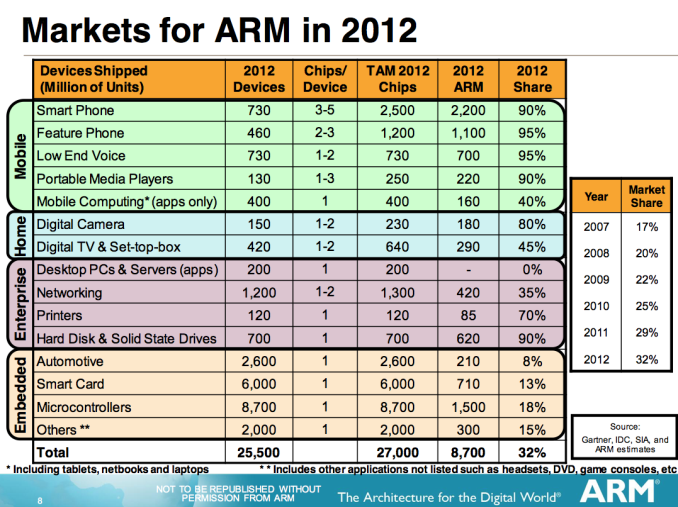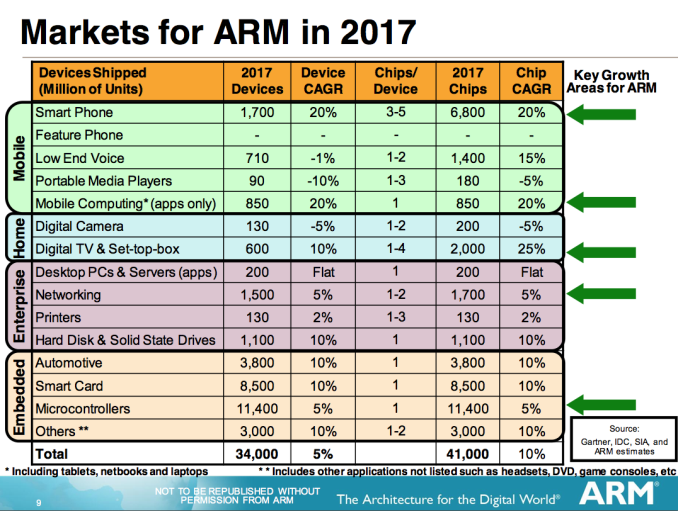The ARM Diaries, Part 1: How ARM’s Business Model Works
by Anand Lal Shimpi on June 28, 2013 12:06 AM ESTMarket Share
In 2012, ARM licensees shipped around 8.7 billion chips. Depending on the market segment, a single device can have anywhere from one to many ARM cores in it. Even looking within a smartphone you have multiple ARM cores not only within the apps processor but also inside the modem.
Although ARM has tremendous market share within the ultra mobile space (90%+), more than half of its shipments come from other segments. Enterprise, digital home, TVs, etc... are all expected to be drivers of growth for ARM in the coming years. By 2017 ARM expects its customers to be shipping roughly 41 billion chips that use ARM IP every year.
Final Words
Business models that leverage the scale and strength of a distributed production model are often very disruptive. ARM designs IP that can be implemented by fabless and fully integrated semiconductor companies very quickly, and at relatively low cost. No one member of the supply chain has to assume a significant amount of risk relative to others in the chain. It’s a far more democratic and partner centric approach to chip supply, which is one reason that it’s done so well.
ARM’s business allows for the creation and sustainability of several chip companies, which in turn keeps prices very low and prevents consolidation of power in any one firm. Although other factors (e.g. modem business, patent licensing) have lead to dominance in specific markets, ARM’s overall impact on the industry is one of promoting competition and keeping (silicon) prices low. ARM quite obviously enables what Qualcomm calls the Internet of things, where nearly everything is connected and computes.
It’s important to note that although our focus on ARM tends to be in the smartphone and tablet space, the majority of its licensed shipments come from other areas. It’s quite likely that ARM’s chances for future growth in terms of margin are in higher-end mobile SoCs, but competition from Intel in one segment surely won’t be the end of the world for ARM.
In the coming parts I’ll be taking a look at some of ARM’s newly announced microprocessor architectures such as the Cortex A12, A53 and A57. I’ll also be looking a little deeper into big.LITTLE and Mali graphics.












64 Comments
View All Comments
Krysto - Friday, June 28, 2013 - link
"It must frustrate ARM just how much attention is given to Intel in the ultra mobile space, especially considering the chip giant’s effectively non-existent market share"Well, it helps to have people like you Anand, who make baseless statements such as "Haswell will take over tablets and beat ARM", a whole year before you even know the details about the Haswell architecture or review it.
Maybe if the media didn't fall for Intel's misleading marketing and press releases so easily, Intel wouldn't get as much attention with nothing to show for it.
cnxsoft - Friday, June 28, 2013 - link
Interesting no growth at all forecast for the "Desktop PC and Servers" up to 2017. What about ARMv8 based servers? Or is it in another category (Networking?).I also thought ARM had a bigger market share in micro-controllers, but 8-bit and 16-bit designs still have a significant market share, so I guess that's partly why.
bill5 - Friday, June 28, 2013 - link
Anand might find it interesting that according to a forbes article, ARM was one of the two finalists for Sony/MS next gen consoles...They supposedly had a performance "bake off", and decided on the Jaguars. With the caveat that although ARM would not be ready with enough performance in time for PS4/XB1, they would be soon after. So, evidently they just missed.
bill5 - Friday, June 28, 2013 - link
linkkkkk http://www.forbes.com/sites/patrickmoorhead/2013/0...A5 - Friday, June 28, 2013 - link
I believe it. I'm thinking A57 will match or beat Jaguar performance, but it wasn't going to be ready for a Q4 2013 mass production launch. Considering that the home console environment is particularly power-constrained, there was probably no reason to wait for ARM to be ready.A5 - Friday, June 28, 2013 - link
*is not, damnitmaybeimwrong - Friday, June 28, 2013 - link
I've been a fan of AT since the 90s, and will undoubtedly continue to be; there's no better tech site out there. That said, I'm uncomfortable with these "Featured Reviews." Perhaps I'm making unwarranted assumptions, but I can't help but read that phrase as "this article was commissioned by a third party, and may remain at the top of the main page for longer than it would have in the absence of payment." I'm not interested in what advertisers think should be featured; I want to see what Anand thinks should be featured. I understand that advertising pays the bills, but there will be far fewer advertisers if readers stop believing in the integrity of the site. While I'm sure this reads as an overreaction, allowing money to dictate editorial content is a slippery slope. Anand, please be careful with these advertising programs.Ryan Smith - Friday, June 28, 2013 - link
In this case I can assure you that you're reading into "featured review" a little too much. Anand likes to use that label for his major industry articles; this article wasn't commissioned by anyone.It also won't remain at the top of the page any longer than any other article. All of our articles are bumped down sequentially based on date of publication.
maybeimwrong - Friday, June 28, 2013 - link
Thanks for the clarification, Ryan. I was paranoid because some of the language in the advertising section seems to allow for the kind of scenario I described. I know articles are bumped down in order of publication, but that doesn't mean the timing can't be adjusted to feature some articles more than others. Keep up the good work :)THF - Monday, July 1, 2013 - link
Well, how is he able to publish the "please do not publish without approval" presentation slides then? Some degree of ARM approval must have been involved in this article.